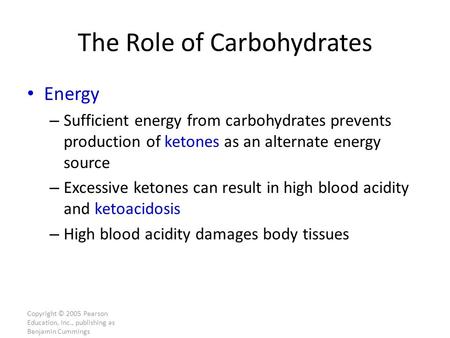Pearson Education Ppt Carbohydrates

PEARSON, ALWAYS LEARNING, MasteringTM Chemistry, and Learning Catalytics are exclusive trademarks in the U.S. And/or other countries owned by Pearson Education, Inc. Or its affiliates. Unless otherwise indicated herein, any third-party trademarks that may appear in this work are the property. Types of Yeast Bakers yeast is available in three forms: Compressed, a mixture of yeast and starch with approximately 70% moisture content; it must be kept refrigerated. Active dry, with virtually no moisture, is dormant and can be stored without refrigeration for months. 5-2a Dehydration removes a water molecule, forming a new bond Short polymer Unlinked monomer Longer polymer Dehydration reaction in the synthesis of a polymer.
Carbohydrates, Proteins, Lipids and Nucleic Acids.1.BIOLOGY CONCEPTS & CONNECTIONS Fourth EditionNeil A. Campbell. Jane B. Reece. Lawrence G. Mitchell. Martha R.
Taylor CHAPTER 3 The Molecules of Cells Modules 3.4 – 3.10 From PowerPoint® Lectures for Biology: Concepts & Connections Copyright © 2003 Pearson Education, Inc. Publishing as Benjamin Cummings.CARBOHYDRATES. Carbohydrates are a class of molecules – They range from small sugars to large polysaccharides – Polysaccharides are long polymers of monomersCopyright © 2003 Pearson Education, Inc. Publishing as Benjamin Cummings.3.4 Monosaccharides are the simplest carbohydrates. Xxcxx school hd 2018 hindi. Monosaccharides are single-unit sugars. These molecules typically have a formula that is a multiple of CH2O. Each molecule contains hydroxyl groups and a carbonyl group.
Monosaccharides are the fuels for cellular work Figure 3.4ACopyright © 2003 Pearson Education, Inc. Publishing as Benjamin Cummings. The monosaccharides glucose and fructose are isomers – They contain the same atoms but in different arrangements Figure 3.4B Glucose FructoseCopyright © 2003 Pearson Education, Inc.
Health Education Ppt
Publishing as Benjamin Cummings. Many monosaccharides form rings, as shown here for glucose Abbreviated structure Figure 3.4CCopyright © 2003 Pearson Education, Inc. Publishing as Benjamin Cummings.3.5 Cells link single sugars to form disaccharides.
Monosaccharides can join to form disaccharides, such as sucrose (table sugar) and maltose (brewing sugar) Glucose Glucose Sucrose Figure 3.5 MaltoseCopyright © 2003 Pearson Education, Inc. Publishing as Benjamin Cummings.3.6 Connection: How sweet is sweet?. Various types of molecules, including non- sugars, taste sweet because they bind to “sweet” receptors on the tongue Table 3.6Copyright © 2003 Pearson Education, Inc. Publishing as Benjamin Cummings.3.7 Polysaccharides are long chains of sugar units. These large molecules are polymers of hundreds or thousands of monosaccharides linked by dehydration synthesisCopyright © 2003 Pearson Education, Inc. Publishing as Benjamin Cummings. Starch and glycogen are polysaccharides that store sugar for later use.

Cellulose is a polysaccharide in plant cell walls Starch granules in Glucose STARCH potato tuber cells monomer Glycogen granules GLYCOGEN in muscle tissue Cellulose fibrils in a plant cell wall CELLULOSE Cellulose molecules Figure 3.7Copyright © 2003 Pearson Education, Inc. Publishing as Benjamin Cummings.3.8 Lipids include fats, which are mostly energy- storage molecules. These compounds are composed largely of carbon and hydrogen – They are not true polymers – They are grouped together because they do not mix with water Figure 3.8ACopyright © 2003 Pearson Education, Inc. Publishing as Benjamin Cummings. Fats are lipids whose main function is energy storage – They are also called triglycerides. A triglyceride molecule consists of one glycerol molecule linked to three fatty acids Fatty acid Figure 3.8BCopyright © 2003 Pearson Education, Inc. Publishing as Benjamin Cummings.
The fatty acids of unsaturated fats (plant oils) contain double bonds – These prevent them from solidifying at room temperature. Saturated fats (lard) lack double bonds – They are solid at room temperature Figure 3.8CCopyright © 2003 Pearson Education, Inc. Publishing as Benjamin Cummings.3.9 Phospholipids, waxes, and steroids are lipids with a variety of functions. Phospholipids are a major component of cell membranes. Waxes form waterproof coatings.
Steroids are often hormones Figure 3.9Copyright © 2003 Pearson Education, Inc. Publishing as Benjamin Cummings.3.10 Connection: Anabolic steroids and related substances pose health risks.
Anabolic steroids are usually synthetic variants of testosterone. Use of these substances can cause serious health problems Figure 3.10Copyright © 2003 Pearson Education, Inc. Publishing as Benjamin Cummings.